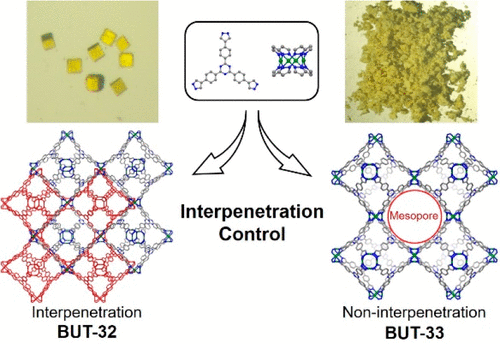当前位置:
X-MOL 学术
›
J. Am. Chem. Soc.
›
论文详情
Our official English website, www.x-mol.net, welcomes your
feedback! (Note: you will need to create a separate account there.)
Kinetically Controlled Reticular Assembly of a Chemically Stable Mesoporous Ni(II)-Pyrazolate Metal-Organic Framework
Journal of the American Chemical Society ( IF 14.4 ) Pub Date : 2020-07-11 , DOI: 10.1021/jacs.0c05074 Tao He 1 , Zhehao Huang 2 , Shuai Yuan 3 , Xiu-Liang Lv 1, 3 , Xiang-Jing Kong 1 , Xiaodong Zou 2 , Hong-Cai Zhou 3 , Jian-Rong Li 1
Journal of the American Chemical Society ( IF 14.4 ) Pub Date : 2020-07-11 , DOI: 10.1021/jacs.0c05074 Tao He 1 , Zhehao Huang 2 , Shuai Yuan 3 , Xiu-Liang Lv 1, 3 , Xiang-Jing Kong 1 , Xiaodong Zou 2 , Hong-Cai Zhou 3 , Jian-Rong Li 1
Affiliation

|
The application scope of metal-organic frameworks (MOFs) is severely restricted by their weak chemical stability and limited pore size. A robust MOF with large mesopores is highly desired, yet poses a great synthetic challenge. Herein, two chemically stable Ni(II)-pyrazolate MOFs, BUT-32 and -33 were constructed from a conformation-matched elongated pyrazolate ligand through the isoreticular expansion. The two MOFs share the same sodalite-type net, but have different pore sizes due to the network interpenetration in BUT-32. Controlled syntheses of the two MOFs have been achieved through precisely tuning reaction conditions, where the microporous BUT-32 was demonstrated to be a thermodynami-cally stable product while the mesoporous BUT-33 is kinetically favored. To date, BUT-32 represents the first example of Ni4-pyrazolate MOF whose structure was unambiguously determined by single-crystal X-ray diffraction. Interestingly, the kinetic product BUT-33 integrates 2.6 nm large mesopores with accessible Ni(II) active sites and remarkable chemical stability even in 4 M NaOH aqueous solution and 1 M Grignard reagent. This MOF thus demonstrated an excellent catalyt-ic performance in carbon-carbon coupling reactions, superior to other Ni(II)-MOFs including BUT-32. These findings highlight the importance of kinetic control in the reticular synthesis of mesoporous MOFs, as well as their superiority in heterogeneous catalysis.
中文翻译:

化学稳定的介孔 Ni(II)-吡唑啉金属有机骨架的动力学控制网状组装
金属有机骨架材料(MOFs)的化学稳定性较弱,孔径有限,严重限制了其应用范围。具有大介孔的坚固 MOF 是非常需要的,但也带来了巨大的合成挑战。在此,两个化学稳定的 Ni(II)-吡唑酯 MOF,BUT-32 和 -33 是由构象匹配的细长吡唑酯配体通过等网状扩展构建的。两个 MOF 共享相同的方钠石型网络,但由于 BUT-32 中的网络互穿而具有不同的孔径。两种 MOF 的可控合成已通过精确调整反应条件实现,其中微孔 BUT-32 被证明是热力学稳定的产物,而介孔 BUT-33 在动力学上更受青睐。迄今为止,BUT-32 代表了 Ni4-吡唑酯 MOF 的第一个例子,其结构由单晶 X 射线衍射明确确定。有趣的是,即使在 4 M NaOH 水溶液和 1 M 格氏试剂中,动力学产物 BUT-33 也集成了 2.6 nm 大介孔和可接近的 Ni(II) 活性位点和显着的化学稳定性。因此,该 MOF 在碳-碳偶联反应中表现出优异的催化性能,优于其他 Ni(II)-MOF,包括 BUT-32。这些发现强调了动力学控制在介孔 MOFs 网状合成中的重要性,以及它们在多相催化中的优越性。6 nm 大介孔具有可接近的 Ni(II) 活性位点和显着的化学稳定性,即使在 4 M NaOH 水溶液和 1 M 格氏试剂中也是如此。因此,该 MOF 在碳-碳偶联反应中表现出优异的催化性能,优于包括 BUT-32 在内的其他 Ni(II)-MOF。这些发现强调了动力学控制在介孔 MOFs 网状合成中的重要性,以及它们在多相催化中的优越性。6 nm 大介孔具有可接近的 Ni(II) 活性位点和显着的化学稳定性,即使在 4 M NaOH 水溶液和 1 M 格氏试剂中也是如此。因此,该 MOF 在碳-碳偶联反应中表现出优异的催化性能,优于其他 Ni(II)-MOF,包括 BUT-32。这些发现强调了动力学控制在介孔 MOFs 网状合成中的重要性,以及它们在多相催化中的优越性。
更新日期:2020-07-11
中文翻译:

化学稳定的介孔 Ni(II)-吡唑啉金属有机骨架的动力学控制网状组装
金属有机骨架材料(MOFs)的化学稳定性较弱,孔径有限,严重限制了其应用范围。具有大介孔的坚固 MOF 是非常需要的,但也带来了巨大的合成挑战。在此,两个化学稳定的 Ni(II)-吡唑酯 MOF,BUT-32 和 -33 是由构象匹配的细长吡唑酯配体通过等网状扩展构建的。两个 MOF 共享相同的方钠石型网络,但由于 BUT-32 中的网络互穿而具有不同的孔径。两种 MOF 的可控合成已通过精确调整反应条件实现,其中微孔 BUT-32 被证明是热力学稳定的产物,而介孔 BUT-33 在动力学上更受青睐。迄今为止,BUT-32 代表了 Ni4-吡唑酯 MOF 的第一个例子,其结构由单晶 X 射线衍射明确确定。有趣的是,即使在 4 M NaOH 水溶液和 1 M 格氏试剂中,动力学产物 BUT-33 也集成了 2.6 nm 大介孔和可接近的 Ni(II) 活性位点和显着的化学稳定性。因此,该 MOF 在碳-碳偶联反应中表现出优异的催化性能,优于其他 Ni(II)-MOF,包括 BUT-32。这些发现强调了动力学控制在介孔 MOFs 网状合成中的重要性,以及它们在多相催化中的优越性。6 nm 大介孔具有可接近的 Ni(II) 活性位点和显着的化学稳定性,即使在 4 M NaOH 水溶液和 1 M 格氏试剂中也是如此。因此,该 MOF 在碳-碳偶联反应中表现出优异的催化性能,优于包括 BUT-32 在内的其他 Ni(II)-MOF。这些发现强调了动力学控制在介孔 MOFs 网状合成中的重要性,以及它们在多相催化中的优越性。6 nm 大介孔具有可接近的 Ni(II) 活性位点和显着的化学稳定性,即使在 4 M NaOH 水溶液和 1 M 格氏试剂中也是如此。因此,该 MOF 在碳-碳偶联反应中表现出优异的催化性能,优于其他 Ni(II)-MOF,包括 BUT-32。这些发现强调了动力学控制在介孔 MOFs 网状合成中的重要性,以及它们在多相催化中的优越性。











































 京公网安备 11010802027423号
京公网安备 11010802027423号